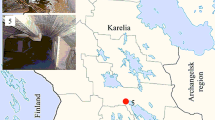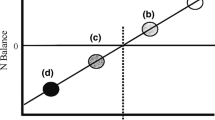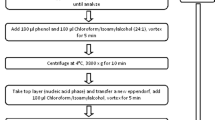Abstract
Rates of protein turnover and synthesis were measured in wild-caught Honey possums (Tarsipes rostratus) in the southwest of Western Australia and compared between males and females with and without pouch young. Possums were injected with 50 μg of 15N-glycine and ammonia collected within 24 h was used as the nitrogen end-product in a single-injection protocol. The overall mean rate of protein synthesis measured was 7.7 ± 0.5 g kg−0.75 day−1, which falls within the range of values reported for other marsupial species. Whole body rates of nitrogen flux and protein synthesis did not vary significantly between males and females with and without young, but females with pouch young showed significantly lower rates of protein synthesis when expressed in relation to metabolic body size. This difference was no longer apparent, however, if the mass of the females was corrected for the estimated mass of the young in the pouch averaging 9.3 ± 1.6 g kg−0.75 day−1 and suggesting that the young should not be considered as part of the metabolic body pool. Whole body rates of protein degradation were significantly reduced in females carrying pouch young, suggesting that protein may be being diverted from the pool to milk production. Calculations indicate that the daily fraction of the female’s nitrogen synthesis rate that needs to be diverted to pouch young to sustain their growth is less than 5%, and may not be detectable with the current methodology.






Similar content being viewed by others
References
Barboza PS, Hume ID, Nolan JV (1993) Nitrogen metabolism and requirements of nitrogen and energy in wombats (Marsupialia: Vombatidae). Physiol Zool 66:807–828
Bradshaw SD, Bradshaw FJ (1999) Field energetics and the estimation of pollen and nectar intake in the marsupial honey possum, Tarsipes rostratus, in heathland habitats of south-western Australia. J Comp Physiol B 169:569–580
Bradshaw FJ, Bradshaw SD (2001) Maintenance nitrogen requirement of an obligate nectarivore, the Honey possum, Tarsipes rostratus. J Comp Physiol B 171:59–67
Bradshaw FJ, Everett L, Bradshaw SD (2000) On the rearing of Honey possums. West Aust Nat 22:281–288
Bradshaw SD, Phillips R, Tomlinson S, Holley R, Jennings S, Bradshaw FJ (2007) Ecology of the Honey possum, Tarsipes rostratus, in Scott National park, Western Australia. Aust Mammal 29:25–38
Dellow DW, Harris PM (1984) Interdependence of energy and protein metabolism—a comparative marsupial-eutherian approach. In: Smith AP, Hume ID (eds) Possums and gliders. Surrey Beatty & Sons, Chipping Norton, pp 107–113
Fawcett JK, Scott JE (1960) A rapid and precise method for the determination of urea. J Clin Path 13:156–159
Fisher DO, Owens IPF, Johnson CN (2001) The ecological basis of life history variation in marsupials. Ecology 82:3531–3540
Freudenberger D, Nolan J (1993) Protein turnover in two kangaroo sub-species (Macropus robustus robustus and M. r. erubescens) from divergent habitats and the sympatric feral goat (Capra hircus). Comp Biochem Physiol 105A:443–448
Gervais MP, Verreaux J (1842) On a new genus of marsupial animals, Tarsipes rostratus. Proc Zool Soc Lond 1842:1–5
Gnanadesikan R (1977) Methods for statistical data analysis of multivariate observations. Wiley, New York, p 324
Golden MHN, Jackson AA (1981) Assumption and errors in the use of 15 N-excretion data to estimate whole body protein turnover. In: Waterlow JC, Stephen JML (eds) Nitrogen metabolism in man. Applied Science Publishers, London, pp 323–324
Hopper SD, Gioia P (2004) The southwest Australian floristic region: evolution and conservation of a global hot spot of biodiversity. Ann Rev Ecol Syst 35:623–650
Hume ID (1982) Digestive physiology and nutrition of marsupials. Cambridge University Press, Cambridge, p 256
Hume ID (1999) Marsupial nutrition. Cambridge University Press, Cambridge, p 434
Jeevanandam M, Brennan MF, Horowitz GD, Rose D, Mihranian MH, Daly J, Lowry SF (1985) Tracer priming in human protein turnover studies with [15N] glycine. Biochem Med 34:214–225
MacRae JC, Lobley GE (1986) Interactions between energy and protein. In: Milligan LP, Grovum WL, Dobson A (eds) Control of digestion and metabolism in ruminants. Prentice-Hall, Englewood Cliffs, pp 367–385
Munks SA, Green B (1995) Energy allocation for reproduction in a marsupial aboreal folivore, the common ringtail possum (Pseudocheirus peregrinus). Oecologia 101:94–104
Munks A, Green B, Newgrain K, Messer M (1991) Milk composition in the common ringtail possum, Pseudocheirus peregrinus (Petauridae: Marsupialia). Aust J Zool 39:403–416
Nagy KA (2005) Field metabolic rate and body size. J Exp Biol 208:1621–1625
Nagy KA, Seymour RS, Lee AK, Braithwaite R (1978) Energy and water budgets in free-living Antechinus stuartii (Marsupialia: Dasyuridae). J Mammal 59:60–68
Nagy KA, Lee AK, Martin RW, Fleming MR (1988) Field metabolic rate and food requirement of a small dasyurid marsupial, Sminthopsis crassicaudata. Aust J Zool 36:293–299
Nagy KA, Meienberger C, Bradshaw SD, Wooller RD (1995) Field metabolic rate of a small marsupial mammal, the Honey Possum (Tarsipes rostratus). J Mammal 76:862–866
Nagy KA, Girard IA, Brown TK (1999) Energetics of free-ranging mammals, reptiles, and birds. Annu Rev Nutrit 19:247–277
Picou D, Taylor-Roberts T (1969) The measurement of total protein synthesis and catabolism and nitrogen turnover in infants in different nutritional states and receiving different amounts of dietary protein. Clin Sci 36:283–296
Richardson KC, Wooller RD, Collins BG (1986) Adaptations to a diet of nectar and pollen in the marsupial Tarsipes rostratus (Marsupialia: Tarsipedidae). J Zool (Lond) 208:285–297
Riek A (2008) Relationship between milk energy intake and growth rate in suckling mammalian young at peak lactation: an updated meta-analysis. J Zool (Lond) 274:160–170
Russell EM (1982) Patterns of parental care and parental investment in marsupials. Biol Rev 57:423–486
Russell EM, Renfree MB (1989) Tarsipedidae. In: Walton DW, Richardson BJ (eds) Fauna of Australia: Mammalia. A.G.P.S, Canberra, pp 769–782
Smith AP, Green SW (1987) Nitrogen requirements of the sugar glider (Petaurus breviceps), an omnivorous marsupial, on a honey-pollen diet. Physiol Zool 60:82–92
Smith AP, Lee AK (1984) The evolution of strategies for survival and reproduction in possums and gliders. In: Smith AP, Lee AK (eds) Possums and gliders. Surrey Beatty and Sons, Sydney, pp 17–33
Smuts DB (1935) The relationship between the basal metabolism and the endogenous nitrogen metabolism, with particular reference to the estimation of the maintenance requirement of protein. J Nutr 9:403–433
Stearns SC (1992) The evolution of life histories. Oxford University Press, Oxford, p 249
Stein TP (1981) 15N-glycine as a tracer to study protein metabolism in vivo. In: Waterlow JC, Stephen ML (eds) Nitrogen metabolism in man. Applied Science, London, pp 345–356
Stein TP, Settle RG, Albina JA, Melnik G, Dempsey DT (1986) The use of non-essential 15N for measuring protein synthesis rates. J Nutr 116:1651–1658
Turner V (1984) Banksia pollen as a source of protein in the diet of two Australian marsupials Cercartetus nanus and Tarsipes rostratus. Oikos 43:53–61
van Tets IG (1998) Can flower-feeding marsupials meet their nitrogen requirements on pollen in the field? Aust Mammal 20:383–390
van Tets IG, Hulbert AJ (1999) A comparison of the nitrogen requirements of the eastern pygmy possum, Cercartetus nanus, on a pollen and on a mealworm diet. Physiol Biochem Zool 72:127–137
Vose HM (1973) Feeding habits of the Western Australian Honey Possum, Tarsipes spenserae. J Mammal 54:245–247
Wallis IR, Hume ID (1992) The maintenance nitrogen requirements of potorine marsupials. Physiol Zool 65(6):1246–1270
Waterlow JC (1981) 15N end-product methods for the study of whole body protein turnover. Proc Nutr Soc 40:317–320
Waterlow JC (1984) Protein turnover with special reference to man. Q J Exp Physiol 69:409–438
Waterlow JC, Garlick PJ, Millward DJ (1978a) General principles of the body measurement of whole-body protein turnover. In: Waterlow JC, Garlick PJ, Millward DJ (eds) Protein turnover in mammalian tissues and in the whole body. Elsevier/North-Holland Biomedical Press, Amsterdam, pp 255–249
Waterlow JC, Golden MHN, Garlick PJ (1978b) Protein turnover in man measured with 15N: comparison of end products and dose regimes. Am J Physiol 235:E165–E174
Welle S, Nair KS (1990) Relationship of resting metabolic rate to body composition and protein turnover. Amer J Physiol 258:E 990–E 998
White RG, Hume ID, Nolan JV (1988) Energy expenditure and protein turnover in three species of wallabies (Marsupialia: Macropodidae). J Comp Physiol B 158:237–246
Withers PC, Richardson KC, Wooller RD (1990) Metabolic physiology of euthermic and torpid honey possums, Tarsipes rostratus. Aust J Zool 37:685–693
Wooller RD, Richardson KC, Bradley GO (1999) Dietary constraints upon reproduction in an obligate pollen- and nectar-feeding marsupial, the Honey possum (Tarsipes rostratus). J Zool (Lond) 248:279–287
Wooller RD, Russell EM, Renfree MB (1984) Honey possums and their foodplants. In: Smith AP, Hume ID (eds) Possums and gliders. Surrey Beatty & Sons, Sydney, pp 439–443
Young VR, Yu Y-M, Krempf M (1991) Protein and amino acid turnover using the stable isotopes 15N, 13C and 2H as probes. In: Whitehead RG, Prentice A (eds) New techniques in nutritional research. Academic Press, New York, pp 17–72
Acknowledgments
The financial assistance of the Australian Institute of Nuclear Science & Engineering (AINSE) and the Australian Nuclear Science and Technology Organisation (ANSTO) at Lucas Heights is gratefully acknowledged, along with that of the many ANSTO personnel who have assisted in the development of the methodology. These include David Cohen, Nick Dytlewski, Mike Hotchkiss, Geraldine Jacobsen, Alan Williams, Linda Barry and Dennis Mather. Ian Hume also provided comments on an early draft of this manuscript and we acknowledge the helpful suggestions of two anonymous reviewers. The study was further supported financially by the Australian Research Committee (ARC) and all animal procedures were approved by the University of WA’s Animal Ethics Committee (Project No. 04/100/117). The capture and study of Honey possums in Scott National Park was approved under permit No. SF005330 from the State Department of Environment and Conservation (DEC).
Author information
Authors and Affiliations
Corresponding author
Additional information
Communicated by I. D. Hume.
Rights and permissions
About this article
Cite this article
Bradshaw, S.D., Bradshaw, F.J. Measurement of the rate of protein turnover and synthesis in the marsupial Honey possum (Tarsipes rostratus). J Comp Physiol B 179, 183–192 (2009). https://doi.org/10.1007/s00360-008-0301-9
Received:
Revised:
Accepted:
Published:
Issue Date:
DOI: https://doi.org/10.1007/s00360-008-0301-9




